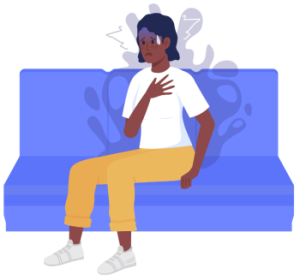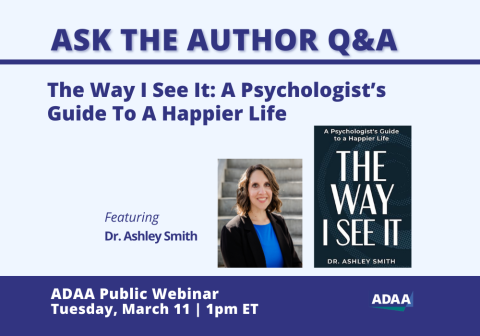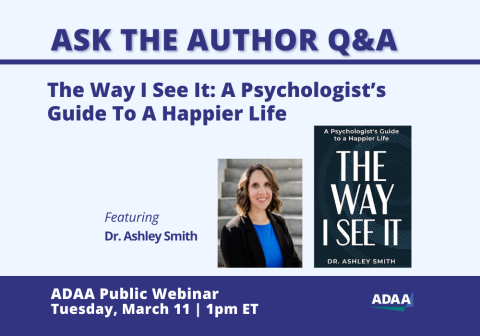Diagnostic and Statistical Manual of Mental Disorders (DSM-5)
For diagnostic criteria and codes, visit the DSM-5 website; requires subscription and login.
Major Depressive Disorder (MDD)
Major depressive disorder, or MDD, is a highly prevalent and costly medical condition with a lifetime prevalence of about 16 percent among U.S. adults and a 12-month prevalence of about 7 percent; about 13.5 million adults experienced MDD in the past year and 34 million will experience it at some point, and women are 1.5 to 3 times more likely to experience it. It can occur at any age, but most have first depressive episode by their early thirties. Numerous effective, evidence-based first- and second-line treatments for MDD are available, and for patients with more chronic or treatment-resistant depression, many treatment strategies have shown promise.
Diagnostic Criteria
MDD is defined by the experience of sad mood or anhedonia (a loss of interest or pleasure) persisting nearly all day, every day for at least two weeks, which distinguishes it from an occasional sad mood or lack of interest that lasts for a few hours or days. For a diagnosis, four additional symptoms are required, including weight loss or gain; sleep disruptions; slowing down or speeding up of physical movements; fatigue or loss of energy; thoughts of worthlessness; difficulty with decision-making; and recurrent thoughts of death or suicide. Symptoms should cause significant distress or impairment in functioning and should not be attributable to drug abuse, medication changes, or medical conditions (e.g., hypothyroidism). Individuals with MDD may also experience significant anxiety, somatization and even psychosis; it increases the risk of suicide and for and morbidity and mortality associated with other medical and psychiatric conditions.
Clinical presentation poses significant variability since individuals do not experience all the same symptoms. And symptom severity, frequency, and duration can differ across individuals and fluctuate over time in the same individual. Some may have a very persistent symptoms that do not remit over a long period of time, and others may have many years of symptom remission between discrete episodes. Generally two out of five people with MDD begin to recover within three months of onset; recovery begins within one year of onset for four out of five people. The longer the current episode, the longer recovery generally takes. The presence of mild to moderate symptoms during a period of symptom recovery is a powerful predictor of whether MDD will occur again. Also several recognized subtypes of depression may require specific treatment, including psychotic depression (hallucinations and/or delusions that occur only in the context of the depressive episode) and atypical depression (normal or exaggerated mood reactivity and often significantly increased sleep and appetite).
Questions for a Nonprescribing Clinician to ask a Referring Physician:
1. What goals do you have for the therapy?
2. How might the side effects of the medications enhance or interrupt the therapy?
3. If the patient describes side effects or nonadherence to the medications, what is the best way for me to contact you?
4. What is the best way for me to contact you to discuss the patient’s progress?
Treatment Options
- First-Line Treatments: Psychotherapy
- First-Line Treatments: Pharmacotherapy
- First-Line Treatments: Combined
- Second-Line Treatments: Psychotherapy
- Second-Line Treatments: Pharmacotherapy
- Second-Line Treatments Combined
- Adjunctive Treatments
- Complementary and Alternative Treatments
- Options for Treatment-Refractory Conditions
- Contraindicated Treatment: Comorbidity Concerns
First-Line Treatments: Psychotherapy
Adults:
Cognitive-behavioral therapy (CBT) evaluates, challenges, and modifies dysfunctional thoughts that maintain depression. Behavioral strategies are also used to increase pleasant activities to treat anhedonia. CBT can be administered in individual or group formats. It is short-term (e.g., 20 sessions) and problem-focused. The most studied psychotherapy for depression, CBT has the largest weight of evidence for its efficacy.
Interpersonal psychotherapy (IPT) is a structured and brief intervention addressing social issues that maintain depression. It can be administered in individual or group formats. It is short-term and problem-focused. Shown to be an effective treatment for depression in numerous studies.
Problem-solving therapy (PST) teaches to define personal problems, develop multiple solutions, identify the best one and implement it, then assess its effectiveness. A moderate evidence base, but shown to be effective for treating depression.
Research indicates that these treatments are consistently more effective than wait-list or other minimal contact treatments.
Meta-analyses that compare the effectiveness of CBT, IPT, and PST indicate no large differences in effectiveness between these treatments.
Children and Adolescents:
Supportive therapy is the initial treatment for youth with brief, mild depression without suicidal ideation or psychosis. Therapy continues for up to 8 sessions until remission. Supportive psychotherapy includes, but is not limited to, active listening and reflection, restoration of hope, problem-solving, coping skills, and strategies for maintaining participation in treatment, psychoeducation, and family and school involvement.
Cognitive-behavioral therapy (CBT) is effective as a monotherapy in depression in youth. CBT focuses on identifying
cognitive distortions that may lead to depressed mood and also utilizes problem -solving, behavior activation, and emotion-regulation skills to help manage and combat depression.
Interpersonal psychotherapy (IPT) has proved effective in pediatric depression; focusing on helping individuals decrease interpersonal conflicts by teaching them interpersonal problem-solving skills and helping them modify communication patterns.
Psychotherapy seems to be more effective for youth ages 12 to 18 years.
Late-Life (Older Adults)
Psychotherapies that meet criteria as evidence-based treatments for geriatric depression include CBT, behavioral therapy, cognitive bibliotherapy, problem-solving therapy, brief psychodynamic therapy, and reminiscence therapy.
Details of note:
• Individual therapy is often more effective than group.
• Effect size seems to be larger for clinician-rated depression than self-rated depression.
• Older age is associated with lower efficacy (but still effective).
First-Line Treatments: Pharmacotherapy
Adults:
Antidepressant selection should be individualized based on clinical factors, including symptom profile, comorbidity, tolerability profile, previous response, potential drug-drug interactions, patient preference, and cost. No antidepressant has been clearly shown to be superior to another; all FDA-approved antidepressant medications should be considered potentially appropriate for first-line treatment.
Selective serotonin reuptake inhibitors (SSRIs), serotonin and
noradrenaline reuptake inhibitors (SNRIs), bupropion, mirtazapine, and several newer agents are typically used as first-line medications because their safety and tolerability may be preferable to patients and clinicians compared to those of tricyclic antidepressants
(TCAs) and monoamine oxidase (MAO) inhibitors.
Mirtazapine and other mixed-target medications can be particularly useful in depression associated with insomnia and weight loss due to side effects of sedation and increased appetite. Bupropion’s mixed effects on monoamines (including dopamine) may be helpful for patients with lethargy and increased appetite. Bupropion has also shown promise for attention-deficit disorder, nicotine addiction and several appetitive disorders.
Children and Adolescents:
Youth with moderate to severe depression could be candidates for pharmacologic treatment. (In mild cases, psychotherapy may be considered first-line treatment.)
Fluoxetine and escitalopram are the only FDA-approved antidepressants for adolescents; fluoxetine is the only FDA-approved antidepressant for preadolescents.
Other SSRIs (sertraline or fluvoxamine) are often prescribed based on comorbidities, side-effect profiles, and personal or family history of response to a specific medication. Paroxetine is rarely used in the pediatrics; lack of data shows efficacy and overall higher side-effect burden.
Late-Life (Older Adults)
About two-thirds of patients presenting with severe forms of depression respond to antidepressant treatment. However, older frail people are particularly vulnerable to antidepressant side effects, especially cardiovascular and anticholinergic side effects, which can compromise compliance and effectiveness. A 2006 Cochrane review did not support any one drug class as more effective than another, though TCAs were less well tolerated.
A general rule: Start low, go slow, and wait longer for efficacy. Older adults often require the same therapeutic doses as for younger adults.
Selective serotonin reuptake inhibitors (SSRIs), tricyclic antidepressants, and monoamine oxidase inhibitors (MAOIs) are evidence-based. The side effect profile of SSRIs is likely preferable; fluoxetine is less ideal due to its long half-life (if medication changes are needed), as is paroxetine due to anticholinergic characteristics and notable drug-drug interactions.
Side-effect profiles and medication or medical illness interactions are a particular concern that should be reviewed carefully.
First-Line Treatments: Combined
Adults:
Meta-analyses indicate that combining pharmacotherapy and CBT leads to better short-term outcomes, with small- to medium-effects sizes, compared to either treatment alone. A similar pattern is observed for combining any psychotherapy and pharmacotherapy, although the evidence base isn’t large enough to examine specific psychotherapy treatments other than CBT.
Children and Adolescents:
The combination of medications and CBT has been shown to be more efficacious in acute treatment of adolescent MDD than either monotherapy in two large U.S. trials.
Late-Life (Older Adults):
Consensus guidelines recommend psychotherapy as an adjunctive treatment to medication in older adults.
Second-Line Treatments: Psychotherapy
Adults:
Social skills training (SST): behavioral treatment that teaches skills and behaviors that help build and maintain social relationships; often also includes assertiveness training. Small to moderate evidence base, but shown to be effective.
Behavioral activation (BA) involves activity scheduling and increasing pleasant activities or positive interactions between a person and his or her environment. Provided individually or in groups; shown to be effective in several studies.
Psychodynamic therapy (PT) aims to increase understanding, awareness, and insight about repetitive conflicts (intrapsychic and intrapersonal); a focus on how early experiences and relationships affect current functioning.
Meta-analyses suggest that these treatments are more effective than wait-list or minimal contact controls; but, some of the clinical trials are relatively small. When limiting analyses to large trials, the estimate of treatment effectiveness decreased: The evidence base for these treatments is not as strong as for the first-line psychotherapies.
Children and Adolescents: N/A
Late-Life (Older Adults): Some data suggest additional psychotherapies (beyond those noted above) may be beneficial or promising, but these include fewer studies and otherwise less stringent criteria of efficacy. They include supportive psychotherapy, personal construct therapy, coping-focused group therapy, interpersonal counseling (shorter-term version of IPT), IPT, and behavioral bibliotherapy, relational/insight therapy, goal-focused therapy, exercise, and longer-term CBT and psychodynamic therapies.
Second-Line Treatments: Pharmacotherapy
Adults:
Tricyclic antidepressants (TCAs) and monoamine oxidase inhibitors are considered second line due to tolerability and safety issues.
Other adjunctive medications include atypical antipsychotics, lithium, adding a second antidepressant, buspirone, and thyroid hormone (T3) among others. When considering these agents, careful attention should be paid to tolerability, short- and long-term safety, and potential drug-drug interactions.
Children and Adolescents:
An alternative SSRI; to date, non-SSRI antidepressants have not been shown to be effective for acute treatment of youth with depression. Non-SSRIs (venlafaxine, duloxetine, bupropion, mirtazapine)
could be considered a third-line treatment; they may be effective in youth with treatment-refractory depression.
Late-Life (Older Adults):
Switch SSRI; augment with lithium or atypical antipsychotic.
Second-Line Treatments Combined
Adults: N/A
Children and Adolescents: N/A
Late-Life (Older Adults): N/A
Adjunctive Treatments
Adults:
Exercise interventions treat depression through consistent and frequent exercise (e.g., 1 hour, 3 times per week for 10 to 14 weeks); more effective than no therapy and no more effective than pharmacotherapy or psychotherapy. The number of high-quality studies is limited.
Children and Adolescents: N/A
Late-Life (Older Adults):
Electroconvulsive therapy (ECT) is an evidence-based intervention for depression broadly; used most frequently among older individuals. Potential medical complications indicate caution is warranted.
Repetitive transcranial magnetic stimulation may be effective.
Complementary and Alternative Treatments
Adults:
Third-wave cognitive and behavioral therapies, which include extended behavioral activation, acceptance and committment therapy, and competitive memory training may be promising but have a very small evidence base.
More studies are needed, but Internet and other computerized treatments hold promise as evidence-based treatments of depression.
Children and Adolescents: N/A
Late-Life (Older Adults): N/A
Options for Treatment-Refractory Conditions
Adults:
Cognitive behavioral analysis system of psychotherapy (CBASP) is specifically designed for chronic forms of depression, integrating cognitive, emotive, and behavior perspectives with teaching interpersonal skills. Clinical trials have been encouraging, particularly in combination with pharmacotherapy; research-evidence base is small.
Electroconvulsive therapy (ECT) remains the most effective approach for treatment-refractory depression, and newer protocols have led to increased appreciation of its safety and efficacy.
Children and Adolescents:
Approximately 35 to 40% of youth will not respond to the initial antidepressant. Treatment change is warranted for youth who have responded inadequately or experienced medication intolerance to the first antidepressant within 8 to 12 weeks. Also reevaluate the patient’s clinical status and psychosocial circumstances when an adequate trial of an antidepressant has been used. Specifically:
1. Confirm the original diagnosis.
2. Assess for continuing or unrecognized comorbidity.
3. Determine if psychotherapeutic interventions are adequate.
Psychotherapeutic interventions can be initiated or intensified, or the mode of psychotherapy may be adjusted (e.g, from supportive therapy to CBT). Recent stressors, family functioning, school interventions, and medication adherence are all areas.
If mood not sufficiently improved: Augmenting agents include
a. Lithium
b. Quetiapine
c. Bupropion
d. Mirtazapine
e. Risperidone
f. Venlafaxine (benefit among adolescents not children)
Late-Life (Older Adults):
Many factors predict a difficult-to-treat depression, including clinical profile (comorbid anxiety, psychotic symptoms, poor sleep, low self-esteem), high medical burden, coexisting cognitive impairment. Partial response poses the risk of chronic relapsing depression, nonadherence to other treatments for coexisting medical disorders, family caregiver burden, and suicide.
Contraindicated Treatment
Comorbidity Concerns
Adults:
It is recommended patients taking antidepressants and SSRIs (especially young adults) be closely monitored by health care providers, family, and caregivers for emergent suicidality, hostility, agitation, mania, and unusual changes in behavior, especially within the first few months of treatment or when dosage is adjusted.
Children and Adolescents:
It is recommended that children and adolescents taking antidepressants and SSRIs be closely monitored by health care providers, family, and caregivers for emergent suicidality, hostility, agitation, mania, and unusual changes in behavior, especially within the first few months of treatment or when dosage is adjusted.
Late-Life (Older Adults):
Dementia and other cognitive changes may reduce the efficacy of pharmacotherapy and may necessitate simplification of CBTs. May be important to include caregivers in interventions with those cognitively-impaired and depressed.
Among populations with dementia, research is limited and heterogeneous, often small sample sizes without full controls. CBTs need to be adapted (including caregivers, among other elements), and behavioral and cognitive-behavioral interventions may improve mood in early (and potentially moderate) stages of dementia (in both the patient and caregivers). Psychopharmacologically, SSRIs and other drugs with no significant anticholinergic effects are considered first-line treatments.
| Updated November 2020 |
















